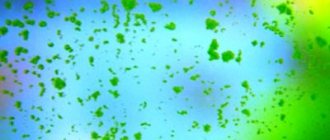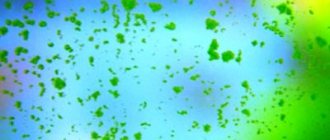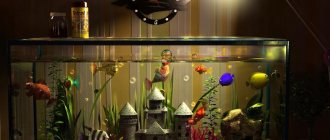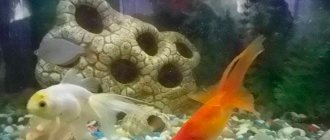Not a single plot of land can do without water. Summer residents and gardeners stock up on it for watering, accumulating it in large containers, and set up ponds, but sooner or later they are faced with the problem of flowering. The water turns green, becomes coated and becomes unusable. If you examine the drop under a microscope, you can see algae. Like all plants, they photosynthesize, so their cells turn green due to the production of chlorophyll.
The process of water blooming in nature
In artificial reservoirs in summer cottages there are unicellular blue-green algae, which are cyanobacteria. Almost 2.4 billion years ago, these microorganisms formed oxygen in the Earth's atmosphere. Along with cyanobacteria, protozoa live in the ponds, including dinoflagellates, which are involved in flowering.
It may surprise you, but nothing actually blooms in water. This term is folk, not scientific. The fact is that the active reproduction of microorganisms by fission provokes excess heat and nutrients. Because of this, the water acquires a green tint. This happens not only in reservoirs and in containers in summer cottages, but also in rivers, lakes, seas and oceans. This spectacle looks fantastic, and you can even see it from space. Environmentalists are sounding the alarm, since recently this phenomenon has ceased to be purely natural and has become the cause of anthropogenic pollution of aquatic ecosystems, to which global warming has also been added.
In the reservoirs of the northern regions, blue-green algae predominate, giving the water a green color. In other places on the planet you can find brown, red or pink water, as it contains other types of microscopic organisms. In the American states of California and Florida, for example, red tides are not uncommon. Huge populations of dinoflagellates give these colors to the water. Scientists and historians suggest that it is this phenomenon that is described in the first of the “Ten Plagues of Egypt” (“Punishment by Blood”): “...And all the water in the river turned into blood...”.
The lifespan of bacteria is very short. During flowering, they die off, sinking to the bottom. There are billions of them in the water, so the process of their decay is accompanied by the absorption of oxygen, which causes the death of fish and other populations of water bodies. But this is not the only reason for the pestilence. The products of rotting microorganisms are toxic. It is not allowed to eat fish from heavily blooming water bodies. Such “gifts of the seas” can cause severe poisoning and serious illness.
What danger does flowering pose?
A small bloom does not mean some kind of global catastrophe for underwater inhabitants.
If the problem is not resolved in time, the flowering will become large-scale, the consequences will be as follows:
- The amount of nutrients in the water area will decrease.
- Oxygen levels will decrease.
- An imbalance in the aquatic ecosystem will appear.
- Some fish may die, while others, more resistant ones, will begin to get sick and waste away.
The presence of green water is a clear indication of an imbalance in the aquatic environment; such a violation will not disappear on its own; the problem of why the water in the aquarium turns green should be solved immediately.
Create a harmonious water world
Cyanobacteria are the beginning of the food chain, its first link. To prevent the activation of bacteria, introduce those who will feed on them into the pond. Even if microorganisms multiply with high activity, they will not cause water blooms, since they will be eaten by fish and other populations.
The most productive in terms of destroying harmful microorganisms are considered to be crayfish and some types of fish, for example, carp. This population will naturally keep your pond clean.
Pool chemicals used by FORUMHOUSE members
In the fight against muddy water, users of our portal use:
| Means | What is it used for? |
| Chlorifix | It is used as an “ambulance” for chlorinating green pool water. |
| Chlorilong | “Long chlorine” helps to avoid blooming, cloudiness and greening of water. |
| Desalgin | A long-lasting and powerful sludge control agent. |
| Algaecide | Destroys the shell of cyanobacteria and actually destroys algae. |
| Aqua-Flor | Removes small particles of organic matter from the surface of the water. |
| Calcinex | Stabilizes hard water. |
| Bayroclar Duo Tab | Chlorine-free pool water care product. |
Pool water care systems like “three in one” work well, for example, Algaecide, supplemented with long-lasting chlorine.
Also, the pool owner’s personal set of chemicals must include:
- good product for cleaning pool edges;
- powerful cleaners that destroy bacteria during general pool cleaning;
- products that are added to the pool before storing it for the winter.
You need various thermometers for measuring water temperature, testers showing the CL content and PH value, dispensers-floats for large “long chorus” tablets.
Protect the pond from the heat
Blue-green algae love warmth. In extreme heat they reproduce especially quickly. A person cannot influence the weather, but he can lower the temperature of the water. Start taking measures at the stage of organizing a reservoir. Place it not in the open sun, but in the shade, and take care to deepen the bottom, since in shallow reservoirs the water heats up quickly.
A good solution is to interfere with photosynthesis of bacteria. To do this, grow aquatic plants with large leaves. Water lilies and floating pondweed are most suitable. It is desirable that the leaves cover about a third of the surface of the pond. If you don’t want to care for the plants, use special paints for shading the water. They can be found on sale.
Illiterate service
An unscrupulous or inept approach to caring for aquarium inhabitants becomes the most common reason why the water in an aquarium turns green.
Usually aquarists, especially beginners, make the following mistakes:
- Irregular cleaning . Poor cleaning of the container not only leads to water blooms, but also provokes fish diseases. Regular cleaning includes cleaning the aquarium walls and decorative elements from plaque, as well as weeding and pruning overgrown aquatic plants, cleaning the filter and soil.
The smaller the aquarium tank, the more often it should be cleaned, for example, a small 15 liter tank is cleaned weekly, and a large 150-200 liter aquarium is serviced once a month.
- Incorrect water replacement . Both frequent and too infrequent water changes lead to rapid growth of green algae. Remember that water changes are carried out every 2 weeks, and up to 30% of the total water volume should be replaced at a time. When adding new water, do not forget to let it sit (1-2 days) to get rid of excess chlorine.
The temperature of the water added to the aquarium and the water drained should be identical. When replacing, it is better to use a siphon, otherwise turbidity will form in the container.
- Unsuitable food . Poor-quality, low-grade fish food leads to active growth of algae. This problem can be easily resolved:
- Buy only high-quality food from reputable manufacturers.
- Feed your aquarium inhabitants taking into account their natural needs.
- The amount of food should be such that the fish eat it in 1-2 minutes.
- Immediately remove excess fertilizer.
Reduce Nutrients
Bacteria love phosphorus very much: control its content. For these purposes, promptly remove fallen leaves, dead aquatic plants and remnants of fish food from the pond. Cleaning can be done manually, or you can install special filters that will remove debris for you. These devices are sold in specialized stores and are called skimmers. The disadvantage of this equipment is that it is powerless against silt, so it is impossible to do without accompanying measures. And one more important point: strictly follow the dosage of fertilizers for aquatic plants, if you apply them.
Water vacuum cleaners are in great demand among summer residents. According to the principle of operation, they do not differ from household devices that are found in every home. Water options draw in liquid and then filter it. The sludge goes into the mud collector, and clean water is sent back to the pond.
A water vacuum cleaner is used to clean ponds whose bottom is made of concrete or covered with film. If there are pebbles at the bottom, then this device will inevitably deteriorate.
Consequences for water bodies
A critical concentration of microorganisms makes water unsuitable for human use. You should not drink it, as harmful microbes can cause severe poisoning. Swimming is not recommended. Once in the body, bacteria cause serious infections, conjunctivitis, meningitis, and allergic reactions.
The water bodies themselves are also suffering. Toxic substances released by algae destroy all living things. Stagnation and clogging of ponds leads to a decrease in oxygen levels, which affects the fish. Poisoned fish are eaten by waterfowl, mammals, and humans - the consequences are lethal, and all links in the long chain of the eco-system suffer.
Since there will be no one to eat the plants, when they die, they settle at the bottom of the reservoir, provoking the formation of fungi on which putrefactive bacteria settle. They, in turn, self-destruct, unable to cope with the consumption of carbon dioxide, which they themselves emit. From a beautiful reservoir with clear water, the pond turns into a putrid, stinking pit.
One of the consequences of the phenomenon is the death of fish
Fight water stagnation and control pH levels
Standing water blooms instantly. Knowing this, many land owners develop flowing reservoirs. But this opportunity is not always available to everyone. The simplest solution is to install a fountain. Firstly, this will prevent flowering, and, secondly, it will add attractiveness to your site. An alternative to a fountain is an aerator. The main task is to combat congestion using any methods available to you. In this case, the population of the reservoir will feel better and will begin to feed more actively on microorganisms.
Controlling the pH level is equally important. It should be either neutral or slightly sour.
Effective ways to combat green water
But what to do if the reasons why the water in the aquarium turns green seem to have been established and destroyed, but flowering processes are still observed?
If greening has grown into a global phenomenon, then you will have to do the following:
- Temporarily transplant the aquatic inhabitants into another container (make sure that the characteristics and parameters of the water are similar).
- Place aquatic plants in a container filled with water with the addition of methylene blue.
- Remove all decor from the aqua and rinse it thoroughly. Do the same with equipment.
- Rinse the aquarium tank completely. Pour pre-settled water into the aquarium and return the plants and living creatures to their place.
You can use other methods as well.
Natural cleansing
1-Snails 2-Catfish 3-Pecilia 4-MolliesTo achieve good results and get rid of active algae naturally, orderlies are needed in the aquarium:
- catfish that actively eat plaque on the walls of the container and decorations;
- snails and fish of the pecilia and mollies breeds, which also readily feast on microscopic algae;
- planktonic crustaceans, they pass water through themselves and naturally purify it.
To stimulate natural orderlies to be more active, temporarily reduce the diet, reduce the duration of lighting and increase aeration.
Mechanical cleaning
To do this, the aquarist should acquire a powerful filter, but in accordance with the volume of the aqua, and do not forget to regularly clean the filter sponges.
Other equipment will also be required:
Diatom filter
Providing higher quality, complete purification and disinfection of water.
UV sterilizer
Capable of regulating the number of microscopic organisms.
Chemical purification
In extreme cases, you can resort to specialized drugs that will quickly help resolve the issue of why the water in the aquarium turns green.
Experienced aquarists include the following as the best remedies:
Hyacinth
It is added at the rate of 1 ml of coagulant per 10 liters of water (when using hyacinth, microorganisms die within 24 hours, their remains are removed through filtration systems).
Erythromycin
The antibiotic is added to the container in a volume of 250 mg per 100 liters of water.
Streptomycin
The antibiotic is added in an amount of 3 mg of the product for each liter of water.
Tetra AlgoStop-depot tablets
Slowly dissolving tablets, they dissolve in water over the course of a month, gradually cleaning the entire container.
Special solution Tetra AlguMin-Plus
Liquid of biological origin.
All of the listed drugs are harmless to aquarium inhabitants and can be used once.
Special anti-blooming agents
If you did not follow the recommendations for preventing the bloom of a reservoir, then special means will help you fight the problem. Algaecides with a wide variety of compositions can be found on the market. If there are cultivated plants and fish in your pond, then choose ones that are harmless to them.
Cyanobacteria can also be destroyed using natural algaecides, which include barley straw - the cheapest and most abundant product. Simply immerse a bunch of straw in a net at the bottom of a pond or pool, you can also leave it on the surface, but the effect in this case will not be as strong. If there is no straw, replace it with yarrow. Follow the same principle.
Plant plants responsible for water purification. Aerochonia, also called water hyacinth, is good in this regard. The plant copes with its task perfectly, which is why it is used in wastewater treatment plants. Aerochonia is not only useful, but also beautiful.
Ultraviolet lamps will also come to the rescue, the light of which destroys microorganisms, not only on land, but also in water. Blue-green algae are also afraid of this light, so they stop reproducing and stop growing. Such lamps do not have a detrimental effect on the biological composition of water and do not interfere with the development of microflora. If the microclimate in your pond is unfavorable, ultraviolet light alone is not enough. In addition to it, use other recommended products.
If you want your pond to be happy, give it as much attention as possible. A greater effect can be achieved if the above methods are used in combination.
The main reasons for green blooms
Green water is evidence of rapid reproduction of unicellular algae in a home aquatic system. Euglena, a simple microorganism characterized by its ability to survive in almost any conditions, grows especially actively. Moreover, Euglena green can grow both in light (with the presence of photosynthesis) and in the dark, feeding on bacteria. Dealing with the parasite is difficult, but quite doable.
There are several catalysts for this phenomenon. To successfully deal with greenery, you need to find out its source and remove the culprit. Let's look at the main reasons why the water in an aquarium turns green.
Excess of organic matter
Organic matter includes the remains of fish, dead particles of aquatic plants, and tiny pieces of shrimp and snail shells. All these components quickly decompose and actively release nitrogenous compounds, which, in turn, become food for algae.
The more organic matter there is in the tank, the faster the algae grow and multiply, turning the water green.
You can understand that the reason is an excess of organic matter by the presence of a significant amount of residues from the “molting” of aquatic inhabitants and excrement. Filling an aquarium with waste not only leads to rapid growth of algae, but also poisons the aquatic environment, reducing the quality of life of the fish.
What to do:
- Thin out the dense population. Transplant some of the living creatures into other banks.
- Adjust feeding and do not forget to immediately remove any uneaten food.
- Siphon the bottom of the aquarium.
Excessive vegetation
Aquatic plants actively produce CO2 (especially in the dark). Carbon dioxide is involved in the process of feeding algae, which increases their growth.
What to do:
- Weed out aquatic flora.
- If necessary, you can replace plants with slow-growing ones. For example, Anubias nana, Thai fern, cryptocorynes, liverwort monosolenium, etc.
Excessive lighting
Under conditions of good photosynthesis, green algae actively reproduce. Rapid flowering can be observed if the jar is under direct sunlight or the aquarium owner uses too powerful a lighting device.
Understanding the source of the problem is simple:
- the aquarium is installed next to a window facing south, southeast;
- The container is illuminated for more than 12 hours in a row;
- The power of the light source does not correspond to the volume of the jar.
What to do:
- Change the location of the aquarium (it should be at least 2 m from natural light).
- Calculate the level of light required for your aquarium . Here, lumen indicators are used for each liter of water (the number of lumens per W is indicated on the device box). There are 3 gradations of lighting intensity: 15-25 Lm/l low, 25-50 Lm/l medium and from 50 Lm/l high.
Daylight hours should be up to 12 hours in summer and up to 10 hours in winter.
When populating an aqua with fish, it is desirable that they all have approximately the same requirements for light levels. For example, for a small container of 40-50 liters of volume, populated with shade-loving species (low light level), a light source with a power of 10 W and a total luminous flux of 900 Lm is required. When calculating, we determine that 1 liter of water will account for 22.5-23 Lm, which is within the standards.
Insufficient filtration
With weakened and poor filtration, contaminants accumulate in the water, which, when their concentration increases, allow algae to grow.
After all, any waste becomes an excellent breeding ground for it. What to do:
- Replace the old and unusable filter.
- Select new equipment that matches the volume of the can.
- Clean the filter periodically (every 2-2.5 weeks).
- Change the sponges in the device body annually.
Provide your aquarium with optimal filtration rate. The most suitable is 2-4 volumes per hour.
Is it possible to swim
Is it possible to swim in a river or lake with blooming water? The answer is clear – no, you can’t. This is due to many harmful microbes and nitrates that can cause poisoning in humans. In addition, after swimming in such a body of water, you can become infected with diseases such as meningitis and conjunctivitis, not to mention various types of allergic reactions.
And it’s also not worth fishing in such a place, if it is still preserved. When water blooms, many advise looking for fish in places where other streams and rivulets flow into a lake or river, since blooms almost never happen here. Another option is to look for fish near the shore where the surf occurs. In general, in large lake-type reservoirs at depth, fish are still able to feed themselves. Therefore, the catch can be found there too.
How to solve problems
If you follow the above rules, there should be no problems with water in the pool. But if they appear, the situation can almost always be corrected.
| Problem | Solution |
| Measure and adjust pH level. |
| Add 200-300 ml of Algaecide per 10 m³ of water. Add Aqua-Flor for more intensive filtration. |
| Adjust pH. Carry out shock chlorination. Add flocculant. Filter for 24 hours. |
| The procedure is as in paragraph 3. |
| Use Decalcite according to instructions. |
| The first method: equalize the pH, perform shock chlorination, and wash the filter 5 times a day. Wait 36 hours, test the water, bring it to normal parameters. Second method: drain the water and thoroughly treat the pool with Decalcite. Fill the pool and maintain the correct pH level. |
Add plants to your pond
The presence of a sufficient number of aquatic plants in the pond allows for better absorption of nitrates produced by fish from excrement and food waste. This deprives the algae of their primary nutrition.
Floating plant cleaners
will also provide shade and reduce sunlight entering the pond, which will help slow the growth of harmful algae.
Underwater plants oxygenators
they release oxygen into the water; in addition, they do not require a special landing; they can simply be attached to a stone or any other weighting material.
You know the saying... "Prevention is better than..."
We hope you found these 6 tips helpful.
Green muddy water is a nightmare
, and preventing its occurrence is a much simpler and less time-consuming task than subsequently trying to get rid of it.
When a pond's ecosystem is disturbed, a phenomenon known as "green water" occurs. It is caused by the growth and spread of a certain type of algae that is evenly distributed throughout the pond water. (Not to be confused with filamentous algae, which tend to grow in thick strands or clumps).
Green algae are microscopic single-celled organisms that thrive in warm, nutrient-rich water with plenty of sunlight.
For this reason, algae problems are widespread during the summer months.
Algae reproduce best in new ponds where there are no flowering plants,
providing shade and competing for available nutrients, and there are no natural algae eaters to keep algae growth in check. The result is a pond filled with water, resembling a swamp.
Technical aeration and filtration
Some owners, looking for something to clear their pond of green blooms, choose pond equipment. Conveniently, equipment such as an air compressor and filters can be found for a reservoir of any size. It enriches the water with oxygen, prevents pollution, cleans and helps maintain the lake in excellent condition.
The equipment is easy to install and operate, but the filters need to be cleaned periodically, and not everyone is ready to invest in such equipment, especially when the lake is large.
Prevention
What to do to prevent active proliferation of microalgae:
- Clean the aquarium regularly and replace the water.
- Control the light level. The distance to the window should be 1.5 m. The duration of artificial lighting in winter should not exceed 10 hours, in summer - 12 hours.
- Place aquatic inhabitants in the aquarium for which microalgae are food. Such residents can be, for example, Daphnia crustaceans.
- Plant plants that actively absorb nitrates. For example, trumpet elodea.
- Do not exceed the fish food allowance.
- Periodically dilute special cleansing preparations in water in preventive doses. For example, hydrogen peroxide, Streptomycin or Bicillin are used.
Many inexperienced aquarists experience blooming in aquarium water. But don’t be upset: the problem is easily fixed. By adhering to the above recommendations, you can prevent contamination of the aquarium.
Provide partial shade
The simplest algae that cause cloudiness in the water in a pond are plants, and like any other plants, they love sunlight. And that's bad news for any pond that isn't protected from the sun.
Of course, it is not always possible to build a pond in partial shade, but there are always ways to protect it a little from excess sunlight.
Aquatic plants such as water lilies
, whose leaves float on the surface, is a great way.
In addition to pond water lilies, various floating plants cope well with this task - primarily water hyacinth
and
water chestnut
.
They provide partial shade, preventing sunlight from affecting the algae, as well as fish such as Koi carp, which may be sensitive to burns.
Biological treatment with special preparations
So, what can you do to prevent the pond from blooming, but without spending a lot of money, time and effort? As practice shows, the simplest, most accessible and effective way to solve the problem is to use special biological additives. Such preparations will help you forget about flowering and get a pond with crystal clear water and healthy inhabitants.
There are many biological products for the prevention and elimination of water blooms. Preference should be given to certified products from a reputable manufacturer. Here it is impossible not to mention biological products for cleaning ponds and reservoirs BB (P030, P10, P100, P020) from the BioBac company - unique compositions that can be called universal. In addition to the highly effective cleaning of reservoirs of any size and origin, the following preparations:
- prevent turbidity and proliferation of microalgae;
- make the ecosystem balanced, improve its health;
- eliminate plaque on the bottom, odor and foam;
- destroy harmful bacteria, their spores and waste products;
- improve the health of flora and fauna;
- prevent the appearance of insect larvae;
- remove slippery sediment on the bottom and walls (slopes);
- reduce the amount of ammonia, optimize the acid-base balance of water.
The product is completely safe for humans, plants, amphibians, fish and other inhabitants of water bodies. This is explained by its organic composition, which includes beneficial microorganisms and mineral fertilizers.
Features of use
How to get rid of water blooms in a pond using the product is indicated in the instructions. The drug is supplied in containers of different volumes, designed for 2.5, 10, 20, 100 cubic meters of water. Therefore, products should be purchased based on the total area of the reservoir. The contents of the container are evenly scattered over the surface of the water, and the temperature should not go beyond +12-35 oC for the effect to be maximum and fast. It becomes noticeable after 7-10 days and lasts for 5-6 weeks. This is the frequency with which it is recommended to use the product during the warm season.
BioBak guarantees the cleanliness and beauty of your pond. It is widely in demand not only in Russia, the country of production, but also abroad.
Green water
If the pond is blooming, then the question arises of what to do in such a situation. This phenomenon is caused by microscopic algae when they actively reproduce. By the way, they are not only harmless for fish, but also serve as excellent food. But the water loses its aesthetic appearance. Moreover, this greenery can appear within a couple of weeks after filling the reservoir. It is necessary to start preventive measures from the very beginning to keep the situation under control.
For algae, the main factors are heat, light, carbon dioxide and organic matter. Accordingly, your task is to create as few of these conditions as possible in your pond. If the surface of the reservoir is at least 3.5 m2, it is quite easy to take the necessary measures to care for it. The first thing you can do is to populate the pond with plants with wide leaves, which will cover 1/3 of the surface of the water and shade the water. Also plant plants that absorb carbon dioxide from water and mineral salts. Food not eaten by fish should also be promptly removed, as should dead plants or parts thereof.
But your task can be ruined by fish that lift silt from the bottom and muddy the water, as well as powerful pumps.
If your pond is very shallow - no deeper than 45 cm and with a surface less than 3.5 m2, then it is more difficult to maintain the necessary balance of forces in your favor. And in a pond with a fountain and constant movement of water, you can no longer plant the necessary plants, or carps bred in the pond will quickly eat them. Is there a way out in this case? Eat. Moreover, both more expensive and cheaper. Economical methods include a bunch of barley straw or peat in a bag at the bottom, these are also folk methods.
You can populate a pond with daphnia, they feed on such algae, but if there are fish in the pond, they will absorb all the daphnia before they cope with their main task. The chemical topic for solving green water remains relevant.
Meet algaecides. But! Carefully study their instructions, do not overdo it, otherwise the fish will die along with the algae. And it’s better to start using them in advance, before the algae fill the pond.
There are algaecides with selective action, it is temporary, so they need to be reapplied every 1-4 months. And there are algaecides that collect these algae into lumps, which settle to the bottom and all that remains is to collect them with a net from there. You can also find a special dye that does not let sunlight into the water, which algae really need for development. But these are all temporary measures, some for a longer period, others for a shorter period, and only a filter can cope with the problem more radically.
Weeds
There are also harmful algae related to weeds, such as filamentous algae. They attach to the bottom or walls of the reservoir, and form balls in the water. This violates the aesthetics of the water, and fish are not visible behind them. Usually, if higher plants are present in the pond or along the shore, then an ecological balance can occur, and unnecessary flora will not be able to develop in the reservoir in unlimited quantities.
On the other hand, such balls are quite easy to remove from the water with a pitchfork or rake, while they are still not large enough. Just screw them onto the tool and pull them out and put them in the compost heap.
The filter, by the way, only copes well with microscopic algae, but you will still get filamentous algae. Only after such catching is chemical processing possible, so to speak.
By the way, duckweed, when it grows, can also ruin the whole picture; it can also be caught with a net or shovel.
Don’t forget to control coastal plants, some of them tend to grow strongly and quickly and choke out other types of plants, don’t wait for this, start pruning them in time.
IMPORTANT! Use beneficial bacteria and underwater plants!
As mentioned earlier, green water is caused by single-celled plant organisms called algae.
These organisms usually appear when the nitrate and phosphate levels in the pond water are imbalanced (in large amounts), providing the algae with nutrients to grow and thrive in ideal conditions!
These nutrients are increased by some of the points mentioned above, but they can be eliminated with a beneficial bacteria treatment, or you can plant submerged cleaner plants
, which will significantly reduce the level and remove excess organic matter.
As for beneficial bacteria, for example, there is a BIOBAC for guaranteed cleaning of ponds.
This product binds and absorbs green algae particles along with all the fish waste, dead leaves and organic matter that constitute the algae's main food source.
Thus, BIOBAC
prevents their growth and cloudiness of the water!











